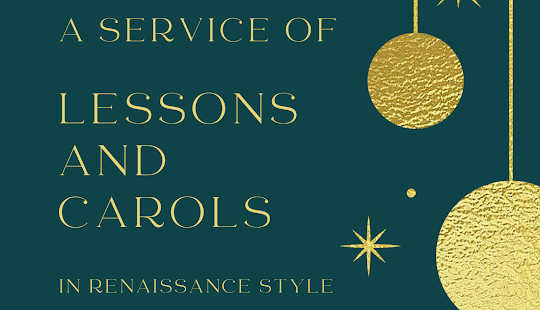Festival of Lessons and Carols: Program Notes by Hannah Cruse (2022)
This year’s Lessons and Carols service is “in Renaissance style.” The word “renaissance” means “a rebirth”--a provocative analogy for what happens during Advent. We wait and watch for signs of Christ coming to earth. This process of waiting and watching stirs a transformation within us, as our spirits are revived with hope, joy, and peace. Theologian and hymnologist Erik Routley wrote that rebirth of the spirit results from “allowing the Word of God in Christ to kill…the natural tendency to trust one’s own powers to save oneself and to achieve reality for oneself.” During Advent, we contemplate and prepare for all that the coming of Christ means: salvation by the remission of our sins, through the tender mercy of God. We celebrate that love has come down to take away death and give eternal life!
Almost all of the music featured in our service tonight hails from the Renaissance period (14th–17th centuries). The Renaissance, especially in England, heavily influenced and still influences our Presbyterian traditions. To understand this, let’s dive into a little history. The tide of “humanism”—a philosophy where man in and of itself is the object of reverence—was rising, starting in the 15th century. In England, composers were exploring polyphony (two or more parts each having a melody of its own), four or more choral parts (as opposed to only two or three), and instrumental accompaniment (rather than a cappella singing). Funding from the monarchy made the performance of such rigorous music possible by institutions like the Chapel Royal.
The Reformation movement, exploding officially in 1517, was, in part, a reaction to humanism. Reformers like Martin Luther (1483–1546) and John Calvin (1509–1564) called for repentance from prioritizing obedience to the Catholic Church above faith in God. Repentance, in their view, included the reform of sacred music. Calvin made the following arguments: because song is prayer, it must be understood by the people in their vernacular language; song must be regulated so it does not do more harm than good; and God’s own words are the only words we can worthily give in praise. Calvin supervised the creation of the 1551 Genevan Psalter, a collection of 126 melodies with familiar phrases and plain repetition set to Psalms and Canticles (songs in the Bible). A number of hymns we still sing today, including Comfort, Comfort Ye My People, originate from this Psalter.
The Reformation catalyzed a tumultuous time for Christianity in England. In 1534, the Church of England broke ties with the Pope, even though Henry VIII was Catholic. Queen Elizabeth’s reign (1558–1603) reinstated Protestantism and the explicitly Reformed 1552 Book of Common Prayer. William Byrd (1539–1623), a Catholic, and Orlando Gibbons (1583–1625), an Anglican, were composing during this time. In 1645, Puritans made the Book of Common Prayer illegal, replaced priests with Presbyterian ministers, and destroyed many Anglican artifacts in a stance for freedom to follow the Word of God. Afterwards, Charles II (King of Scotland from 1649 to 1651 and England from 1660 to 1685) revitalized the neglected Chapel Royal and paid for talented musicians to receive education on the Continent. Henry Purcell (1659–1695), a product of Continental education, incorporated Italian and French techniques into his distinctly English sound. We see in Anglican music from this time a unique integration of styles: sacred and secular, Protestant and Catholic, polyphonic and homophonic, English and Continental.
The work of Byrd, Gibbons, and Purcell affords our choir the opportunity to sing the Lukan Canticles, which are often neglected in Presbyterian worship today. In the 16th century, they played a major role in liturgy. The Church of England–trying to appease both Protestants and Catholics–distilled the daily office into just two services, Morning Prayer and Evensong. The Benedictus traditionally would be sung during Morning Prayer, then the Magnificat and Nunc Dimittis during Evensong. These three New Testament Canticles beautifully orient our spirits towards preparation, expectation, and rest during Advent. Zechariah (Luke 1:68–79), Mary (Luke 1:46–55), and Simeon (Luke 2:29–32) all look back on God’s history with humanity as they rejoice for the future of the world–Jesus Christ.
The music and texts offered tonight, though representing a mere snapshot of our history, illuminate God’s life-giving work throughout the ages. Whether it be through the eyes of Renaissance composers or New Testament saints, we “have seen thy salvation…a light to lighten the Gentiles.” During this Advent season especially, let us fix our gaze and adoration upon Christ’s gift of radical love, just as generations of Christians have done before us.
Sources
“Hymns and Hymnody: Historical and Theological Introductions (Volume 1)” Edited by Mark A. Lamport, Benjamin K. Forrest, and Vernon M. Whaley
“The Story of Christian Music: From Gregorian Chant to Black Gospel, an Illustrated Guide to All the Major Traditions of Music in Worship” by Andrew Wilson-Dickson
“The Church and Music” by Erik Routley
“Hymnology: A Collection of Source Readings” by David W. Music




Comments
Post a Comment